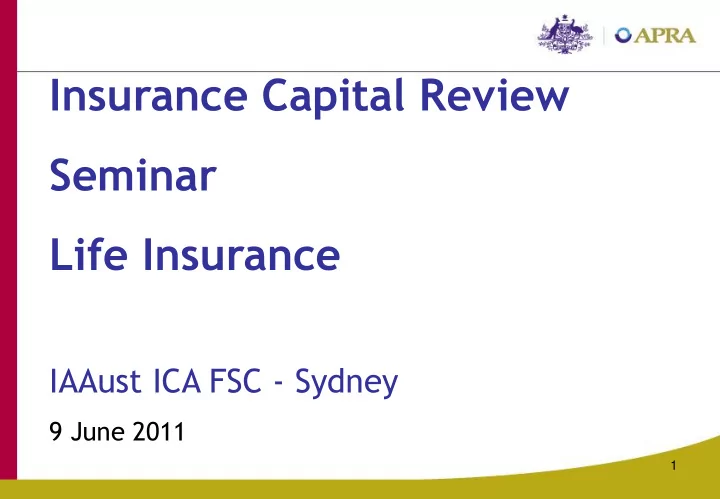

Insurance Capital Review Seminar Life Insurance IAAust ICA FSC - Sydney 9 June 2011 1
Agenda • Major themes from consultation • Capital base • Discount rates • Capital charges – Insurance risk – Operational risk – Asset risk • Questions 2
Major themes from consultation • Proposals were overly complex • Proposals were overly conservative • Proposals were pro-cyclical • Impact varied widely between companies • Minor impact on investment linked funds 3
Capital base - response • Adjusted policy liabilities – Combine all non-discretionary business for TV minimum • Inadmissible assets – Goodwill in genuine arm’s -length investments will be admissible – Tax benefits associated with termination values might become admissible • Quality of capital 4
Risk-free discount rates • Derived from CGS yields • Extrapolate by reference to other instruments • Liquidity premium in certain circumstances – For immediate annuities & fixed term/rate (with TV reducible to APRA minimum) & funeral bonds – Set as a constant for QIS2 (30 bps) – Aim to use a prescribed formula in standards (yet to be developed) 5
Insurance Risk • Random mortality & morbidity • Future mortality & morbidity • Mortality and morbidity event • Longevity • Lapses • Servicing expenses • Correlations • Repricing • Short term losses 6
Insurance Risk - response • Event stress – One event stress affecting both mortality and morbidity – Minimum event stress is a pandemic scenario spread over 2 years • Repricing – Allow repricing from 12 months after reporting date – But not in response to random or event stresses 7
Insurance Risk - response • Termination values – Remove stressed termination values at reporting date – Stressed TVs still apply 12 months from reporting date – Broader product groups reduce impact of TVs • Reduced correlation factor – Future mortality/morbidity reduced from 50% to 25% • Increase risk sensitivity – Lapse stress is no longer a prescribed amount 8
Operational risk Revised formula • α × (max{GP, NL} + |∆|) where: – α is 3% for risk, 0.25% for non-risk (2%, 0.15% reinsurers) – GP is gross premium income – NL is net adjusted policy liabilities – |∆| is the change item based on premiums and/or claims 9
Operational risk • Depends on ‘size’ and change in ‘size’ over 12 months • Separate charges for risk and non-risk business • Lower charges for reinsurers • Change item – Extra capital charge for rapid growth or decline – Measured using premiums and claims – Threshold increased from 10% to 20% – Charge only applies to excess over threshold 10
Asset Risk • Seven asset risk modules – Real interest rates – Expected inflation – Currency – Equity – Property – Credit spreads – Default risk • Aggregated using a correlation matrix • Stresses apply to all admissible assets 11
Asset Risk - response • Real interest rates and expected inflation – Simplify by removing duration dependent factors – Reduce impact at shorter durations – Reduce pro-cyclicality by limiting stresses (max 200 bps for real interest rates) – Remove dependence on inflation assumption Real interest rates Expected inflation + 0.3 x nominal rate 125 bps - 0.25 x nominal rate 100 bps 12
Asset Risk - response • Volatility – Simplify by moving equity volatility into equity module – Reduce pro-cyclicality by changing equity volatility stress to +15 per cent – Remove interest and currency volatility stresses 13
Asset Risk - response • Credit spreads – Improved risk sensitivity – Separate category for re-securitised assets – Separate default and spread stresses – Semi government debt stepped up one counterparty grade 14
Asset Risk - response • Default risk – Simplify by removing the requirement to use stressed reinsurance assets and OTC derivatives • Correlation matrix – Increase some factors to improve consistency 15
Other issues • Aggregation benefit – Correlation factor reduced from 50% to 30% for QIS2 • Methodology – Participating and other discretionary business – Tax assets • General fund – $10m minimum, with offsets 16
Questions? 17
Recommend
More recommend